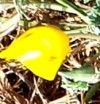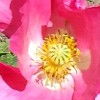







Family Papaveraceae
 Poppy seeds contain small quantities of both morphine and codeine,
but have a short shelf life of a few days.
Poppy seeds contain small quantities of both morphine and codeine,
but have a short shelf life of a few days.
The more powerful, Papaver.Somniferum, produces edible seeds,
and is also the source of the crude drug opium
which contains powerful medicinal alkaloids,
analgesic opiates such as morphine, heroin and codeine.
Most species are lactiferous, and secrete latex when injured.
Fost-tolerant
Very hardy and prefer a sunny position with moist, well-drained soil.
Stamens arranged in two separate whorls.
species also Most flowers have a narrow neck (style) that extends from the stigma to the ovary,
it is conspicuously absent in the poppy. The stigma sits directly on the ovary.
The ovary has fused Carpels


 GENUS Bocconia
GENUS Bocconia
 GENUS Bocconia
GENUS Bocconia
Bocconia

 GENUS Eschscholzia
GENUS Eschscholzia
 GENUS Eschscholzia
GENUS Eschscholzia
Poppy Eschscholzia californica


 GENUS
GENUS
Poppy


 GENUS
GENUS
Poppy

Genus
Papaver (Papaver rhoeas, Papaver somniferum, Papaver orientale, Papaver nudicaule)
The corn poppy of Europe, P. Rhoeas,
is also an annual, but a dwarfer plant, with green hairy finely cut foliage and smaller flowers.
It is brilliant in the fields of Europe, and it has run wild in this country.
The Shirley poppies are the best strain of this species;
in gardens the flowers last longer than the common P. Rhoeas and the plants are neater when out of bloom.
The opium poppy, P. somniferum, is one of the commonest and the most variable.
It is annual, of tall stately habit, and recognized at once by the glaucous hue of its foliage.
The flowers are the largest of any of the annual species,
but unfortunately they are useless as cut-flowers because they drop their petals so quickly.
The Iceland poppy, P. nudicaule, is the glory of the arctic regions.
It ranges over an immense territory and varies remarkably both in the wild and the garden. Orange, red, and white are the chief colors, besides shades of yellow, but the flowers never attain the brilliant scarlet of the corn poppy. Although the Iceland poppy is perennial, it is short-lived, and is commonly treated as an annual or as a short-lived perennial. It is known for the satiny texture and crimpled character of its petals. The flowers are excellent for cutting, especially if the young flowers are chosen and cut in the early morning, a principle which applies to many flowers often supposed to be useless for home decoration.
The oriental poppy, P. orientale, is a longer-lived perennial, and although it has the largest flowers of any species in the genus it has nothing like the fame of the opium poppy. However, it has the double advantage of being easily propagated by either seed or division, and it has a considerable range of color, which is said to be largely due to crosses with P. bracteatum. The latter differs in having large bracts below the flower.
 Eschscholzia (Eschscholzia californica)
Eschscholzia (Eschscholzia californica)
Meconopsis (Meconopsis cambrica, Meconopsis napaulensis)
Stylophorum (celandine poppy)
Argemone (prickly poppy)
Romneya (matilija poppy and relatives)
Canbya (pygmy poppy)
Stylomecon (wind poppy)
Arctomecon (desert bearpaw poppy)
Hunnemannia (tulip poppy)
Dendromecon (tree poppy)



 Poppy seeds contain small quantities of both morphine and codeine,
but have a short shelf life of a few days.
Poppy seeds contain small quantities of both morphine and codeine,
but have a short shelf life of a few days. GENUS Bocconia
GENUS Bocconia  GENUS Eschscholzia
GENUS Eschscholzia 
